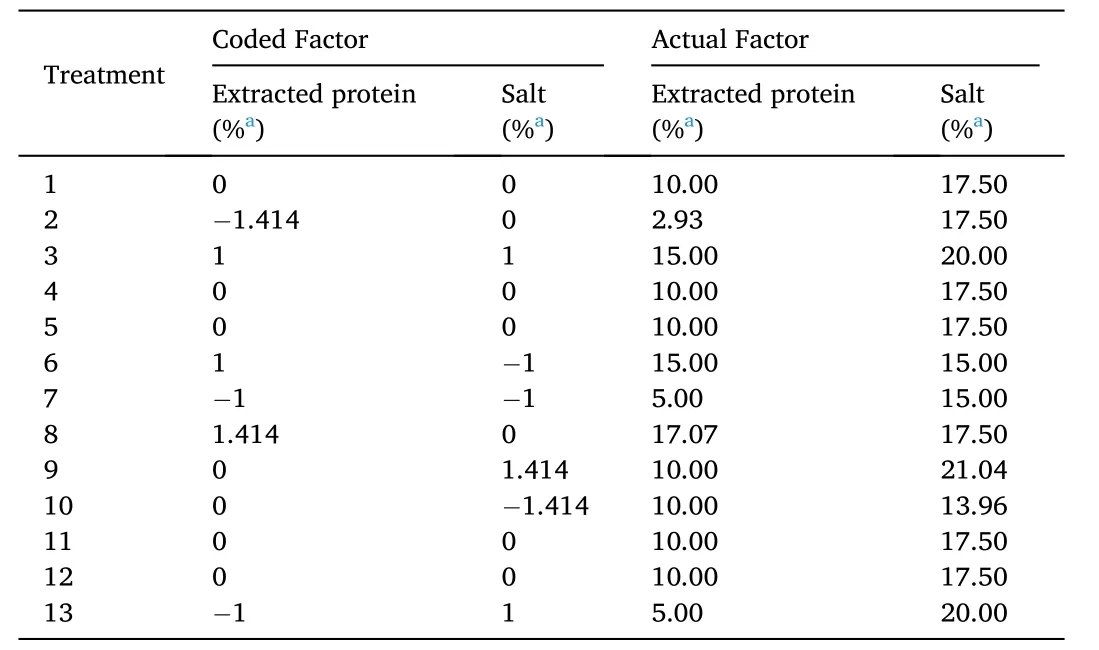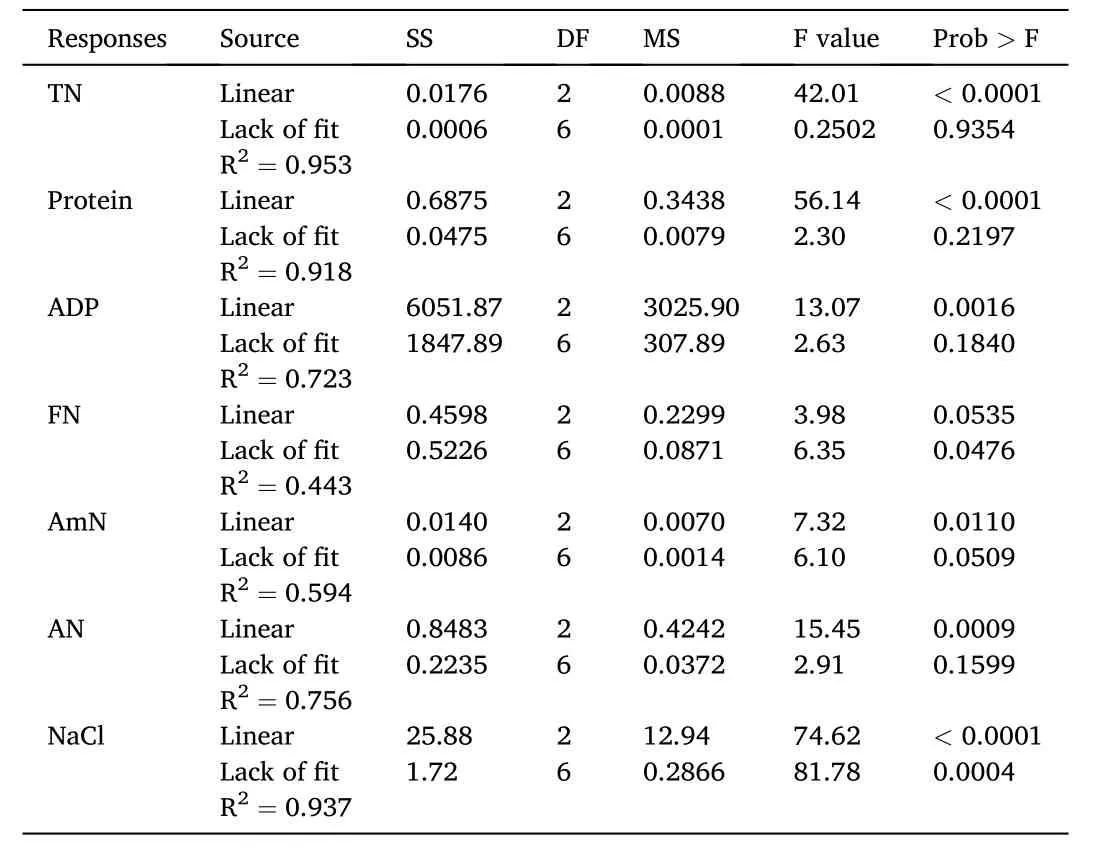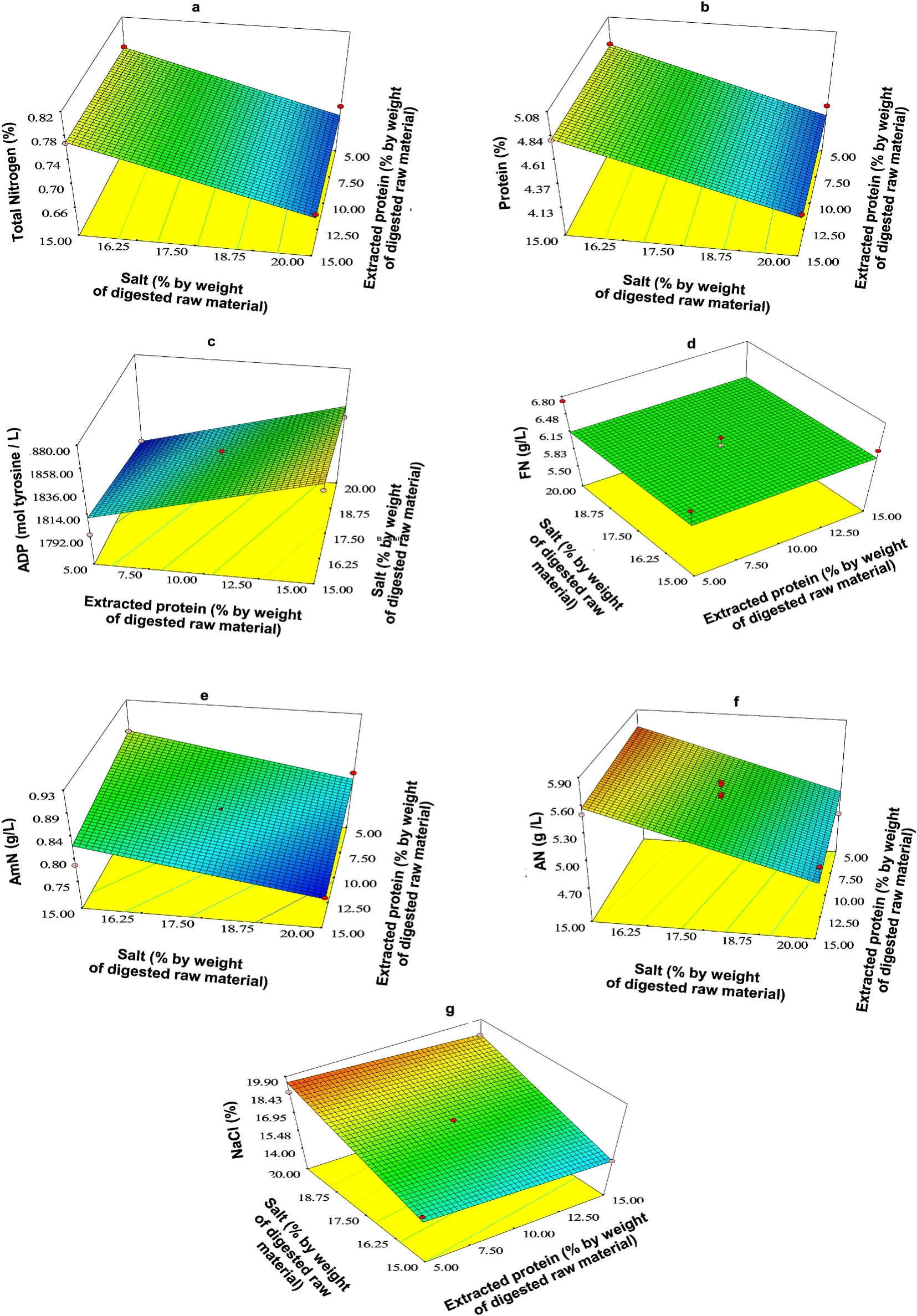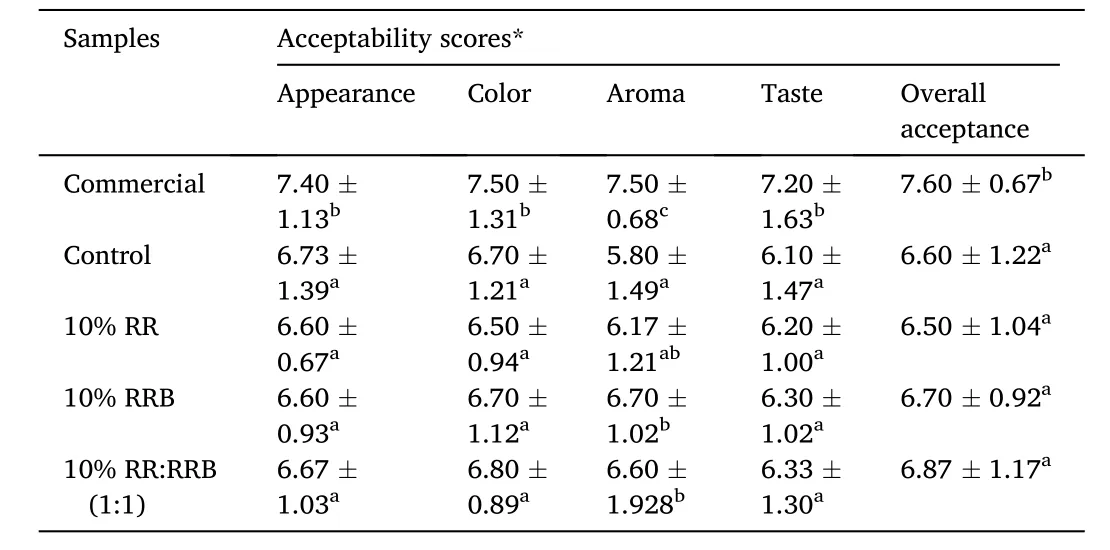Chemical characteristics changes associated with extracted protein and salt addition and effect of different additives in the curing process on sensory acceptance of liquid fermented fish from tilapia frame
Ynwirut Wijitpun, Piynn Chomnwng, Knnik Huisn, Kewt Sootsuwn,Chnnrong Chomnwng,*
aDepartment of Food Technology, Faculty of Agricultural Technology, Kalasin University, Kalasin, 46000, Thailand
bDepartment of Biotechnology, Faculty of Agricultural Technology, Kalasin University, Kalasin, 46000, Thailand
Keywords:
Liquid fermented fish (Nam pla ra)
Tilapia frame
Fermentation
Extracted soybean protein
A B S T R A C T
Liquid fermented fish (Nam pla ra) is a traditional local condiment and popular consumption in Thailand. According to previous research, tilapia frame could be used as a raw material for the production, but the amount of protein received is still below the standard. In addition, there is no information of additives in curing process on consumer preferences. In this research, response surface methodology was used to study the infuence of extracted protein from soybean meal (5-15%) and salt (15-20%) contents on chemical characteristics of Nam pla ra after 4 months of fermentation. The amount of roasted rice and roasted rice bran addition in curing process on sensory preferences were also studied. The results showed the linear effect of extracted protein and salt contents on NaCl content (P <0.05). When extracted protein increased, NaCl content of sample decreased, while increased salt concentration, NaCl content increased. Extracted protein showed linear relationship with autolytic degradation products and formaldehyde nitrogen of sample (P <0.05). Increase in extracted protein concentration caused an increment to both autolytic degradation products and formaldehyde nitrogen. In addition, salt content showed linear relationship with protein, total nitrogen, ammonia nitrogen and amino nitrogen (P <0.05). When increased salt concentration, protein and all kind of nitrogen tested in this study decreased. The statistical models for protein and NaCl contents (as an index of product quality) and our experimental validation,indicated that the models were appropriate to predict values. For acceptability test, there was no significant different in all attributes scores of cured samples with 10% roasted rice, roasted rice bran and mixture of both. In addition, their showed a significant different in all attributes scores lower than the commercial sample. In conclusion, the highest protein content was found in a treatment prepared by added salt content 15% by weight of digested material. Addition of proteins extracted from soybean meal did not lead to increase in protein content of finished product. However, chemical properties of all treatments could meet Thai community product standard.
1.Introduction
A liquid fermented fish (Nam pla ra) refers to product derived from fermenting fish with salt. The mixture is packaged in a container, fermented at ambient temperature for a period of 8-12 months. Appropriate amount of finely ground roasted rice and rice bran or roasted rice bran could be added to fermentation mixture of Nam pla ra before or after fermentation process to enhance natural favor of product. After fermentation, some seasonings such as sugar, tamarind juice, pickled garlic juice, could be added to Nam pla ra, then it will be filtered and heated before packaging (Thai industrial standards institute, 2014). The ishery development policy and strategy division (2018) reported that tilapia production in Thailand increases with the yield of more than 210,000 MT in 2016. Large amounts of fish frames by-product are generated from the frozen fillet industry, and were used in animal feed and fishmeal productions. However, there are a few reports on utilization of tilapia frames by-product as raw materials for production of higher value products, therefore, appropriate strategies should be studies. The traditional process of fermented fish products is normally carried for a long time and uses high salt concentration. From our previously studies,it took 6 months to complete fermentation, and the liquid fermented fish from tilapia frames contained 3.12% protein content, which was less than minimum standard of Nam pla ra (4%) announced by Thai community product standard (Thai industrial standards institute, 2014).Therefore, increasing protein content in Nam pla ra from tilapia frames should be considered. Soybean meal is generally considered as a waste from the food and beverage industry such as soy milk and soybean oil production. This residue still contains a large amount of protein (about 40-50%), which is the most commonly used as alternative protein source in animal feed production because of its highly digestible protein.Thus, the addition of protein extract from soybean meal to increase protein content in liquid fermented fish product from tilapia frames has been studied.
There is still few information on not only using tilapia frames as fermentation raw materials, but also on methods to increase protein content of the product. The purpose of this research is to study the effects of addition of extracted protein from soybean meal and salt on chemical characteristics of liquid fermented fish after 4 months’ fermentation. In addition, to accelerate the fermentation process, raw material pretreatment using crude proteinases from tilapia viscera before fermentation would be applied. Moreover, sensory preferences of products using different additives in curing process; such as roasted rice and roasted rice bran, were also studied. The major goal was to improve the product to meet Thai community product standard.
2.Materials and methods
2.1.Raw materials
Tilapia frame (head, frame and fin) viscera, soybean meal (full-fat),rice and rice bran were purchased from local market in Kalasin Province.Solar salt was purchased from local market in Samut Sakhon Province,Thailand.
2.2.Raw materials preparation
2.2.1.Crude proteinases preparation
Crude proteinases were prepared as described by Nammontree et al.(2014). Tilapia viscera were washed and ground using a blender (Philips, 2115, Japan) for 1 min, with addition of cold distilled water to fish viscera in the ratio of 1:1 (w/w). The ground sample was filtered using double sheet cloth, and filtrate was used as crude proteinases.
2.2.2.Preparation of extracted protein from soy bean meal
The extracted protein was prepared according to the method of Chomnawang et al. (2012). Soy bean meal was mixed with tap water in a ratio of 1:3. The mixture was heated to boil, and maintained for 5 min with stirring, then cooled down to 75°C. The slurry was filtered through a double sheet cloth and squeezed by hand to obtain soymilk. The extracted protein was prepared by coagulating the soymilk using 2% acetic acid (based on the amount of soymilk used). The mixture was vigorously stirred with a stainless steel paddle for 15 s. The mixture was let to stand for 30 min. The curd was separated by filtered through a double sheet cloth and centrifuged at 5000 rpm for 10 min. Chemical compositions of the extracted protein consisting of protein, fat, ash,moisture and carbohydrate contents were 19.27%, 4.71%, 0.71%,67.02% and 8.29% (w/w), respectively. Protein extract was kept in plastic bags and stored at 4°C for further studies.
2.2.3.Preparation of digested tilapia frame
Preparation of digested tilapia frame was prepared according to Nammontree et al. (2014). Frames were cut into the small pieces, then soaked in cold water and kept at 4°C overnight to removed fish slime,blood and fat, then, the cut frames were washed and ground using a grinding machine (Atech Instruments, Khon Kaen, Thailand). Ground sample was mixed with distilled water in the ratio of 1:0.3 (w/w) and then 10% of crude proteinases were added. The mixtures were transferred to glass bottles and covered with polyethylene film. The containers were incubated at room temperature (34-37°C) for 12 h. The digested tilapia frame was used as raw material for liquid fermented fish production.
2.3.Effects of extracted protein from soybean meal and salt addition on chemical characteristics
Liquid fermented fish (Nam pla ra) was prepared using response surface methodology to study the effect of extracted protein from soybean meal and salt on chemical characteristics. The digested tilapia frames were mixed with different levels of extracted protein (5-15%w/wof the degraded tilapia frames) and salt (15-20%w/wof the degraded tilapia frames), which have a total of 13 experimental units (Table 1).The mixtures were transferred to 5 L glass bottles. The mixture was allowed to ferment (anaerobic fermentation) at ambient temperature(33-36°C) for 4 months. After 4 months of fermentation, the whole fermentation mixture was filtered with cheesecloth and the liquid (Nam pla ra) was collected and used for analysis. The experiments were done in triplicate.

Table 1Coded and actual levels of factors generated by central composite design for Nam pla ra from tilapia frame preparation.
2.4.Effects of roasted rice and roasted rice bran addition in curing process on sensory preferences
After 4 months of fermentation, a treatment that showed the highest protein content (15% salt and 5% extracted protein) and meet the standard was selected for this study. The cured Nam pla ra was prepared by mixed fermented Nam pla ra with 10% (by weight) of roasted rice,roasted rice bran or mixture of both (1:1). Rice and rice bran were roasted using a medium-heat on gas stove for 5 min and cooled down before use. The mixtures were incubated at room temperature(32-37°C) inside the building for 28 days. After the curing process, the samples were used for acceptability test in comparison with the control and commercial samples (A total of 5 treatments). The experiments were done in triplicate.
2.5.Determination of chemical characteristics and acceptability test
2.5.1.Measurements of NaCl, total nitrogen, protein and autolytic degradation product (ADP)
Salt content (% NaCl) was determined according to the method of AOAC (2000). Total nitrogen in the samples was determined using Kjeldahl method (AOAC, 2000), and percentage of total nitrogen was calculated. Crude protein content was calculated by converting nitrogen content determined by Kjeldahl’s method (6.25 × N). The ADP content of sample was determined as described by Benjakul et al. (2003). 3 mL of sample was added into 27 mL of 5% (v/v) trichloroacetic acid (TCA),then kept on ice for 1 h and centrifuged at 5000×gfor 5 min. Tyrosine in supernatant was measured as an index of ADP and expressed as mol tyrosine/L using Lowry method (Lowry et al., 1951). All chemical measurements were determined in triplicate.
2.5.2.Determination of formaldehyde nitrogen (FN), ammonia nitrogen(AmN) and amino nitrogen (AN)
FN, AmN and AN contents were determined as described by Klomklao et al. (2006). FN content (g/L) was calculated as: mL of NaOH (pH 7- pH 9) × 0.1 × 14. AmN content (g/L) was calculated as: 5.6 × 0.05 × Y,where Y is the volume of H2SO4(mL). AN was calculated using the following formula: AN content (g/L) =FN content - AmN content.
2.5.3.Acceptability test
The cured Nam pla ra samples were heated to boiling point for 5 min.After cooled down, samples were evaluated by 30 an untrained panel.Panelists were asked to give scores for five attributes: appearance, color,aroma, taste and overall acceptance using the nine-point hedonic scale(a score of 1 represented extreme dislike, 5 represented neither like nor dislike and 9 represented like extremely).
2.6.Statistical analysis
Response surface methodology (RSM) was employed to study the effect of extracted protein and salt contents on chemical characteristics of liquid fermented fish from tilapia frame after fermented for 4 months.The liquid fermented fish were prepared according to a central composite design, consisting of 22factorial design with two levels (-1, +1),five central points (0) and two levels of axial points (-α, +α). The coded values of the independent variables (-1.414, -1, 0, 1, 1.414) were calculated according to a rotatable design (Gacula and Singh 1984).Data were analyzed by regression of response surface to fit the following second-order polynomial to all dependent Y variables. The error assessment was derived from replication of the treatment conditions at central point. The level of significance was de fined at P<0.05. The treatments were designed using a statistical program (Design-expert Version 7.0.0; Stat-Ease, Inc. Mineapolis, MN). For the effect of roasted rice and roasted rice bran on acceptability test after curing process,statistical analysis was performed using the Statistical Package for Social Science (SPSS 17.0 for Windows, SPSS Inc., Chicago, IL, USA). Data were subjected to analysis of variance. Comparison of means was carried out using Duncan’s multiple-range test. The level of significance was set at 0.05.
3.Results
The effects of extracted protein from soybean meal and salt on chemical characteristics of Nam pla ra from digested tilapia frame were studied using RSM.
3.1.The effect on total nitrogen, protein and ADP contents
The correlations of extracted protein and salt on total nitrogen,protein and ADP contents of Nam pla ra were shown in Table 2. Linear effects of salt on total nitrogen and protein contents were observed withR2values of 0.930 and 0.918, respectively, whereas extracted protein content showed the linear effect on ADP value (P <0.05) with R2value of 0.723. The regression coefficient of extracted protein and salt contents on total nitrogen, protein and ADP of Nam pla ra were showed in Table 3. The mathematical models in terms of coded factors were developed as follows:

Table 2Analysis of variance of the effect of extracted protein and salt contents on response parameters of Nam pla ra from tilapia frame.

Table 3Regression coefficient of the effect of extracted protein and salt contents on response parameters of Nam pla ra from tilapia frame.

where: A =extracted protein and B =salt content.
The predictive models of total nitrogen, protein and ADP contents showed a non-significant lack of fit, indicated that these models were appropriate to use for prediction (Table 2). The response surfaces stereograms of total nitrogen, protein and ADP contents of Nam pla ra were shown in Fig. 1a, b, and 1c, respectively.

Fig. 1.Response surface plot for chemical characteristics of Nam pla ra for 4 months’ fermentation with a different extracted protein and salt contents; % are expressed as % w/w of digested raw material.
3.2.Effect on FN, AmN and AN contents
The correlations of extracted protein and salt on FN, AmN and AN contents of Nam pla ra were shown in Table 2. Linear effect of salt on AmN and AN contents of samples withR2of 0.594 and 0.756, respectively were observed (P <0.05). Whereas, both the linear and quadratic effects of extracted protein and salt on FN was found to be not signi ficant. On regression analysis, the regression coefficients of extracted protein and salt contents on FN, AmN and AN contents of Nam pla ra were shown in Table 3. The mathematical models in terms of coded factors were developed as follows:

where: A =extracted protein and B =salt content.
The predictive models of AmN and AN contents showed a nonsignificant lack of fit, indicating that the models were appropriate for prediction. In contrast, the significant lack of fit of FN predictive model was observed, indicating that the model was not appropriate for prediction (Table 2). The response surfaces plot for FN, AmN and AN contents of Nam pla ra after 4 months of fermentation were shown in Fig. 1.When considering the surface response graphs, salt concentration showed the negative linear effect to AmN and AN contents samples,explained by decreasing in AmN and AN contents as salt concentration increased (Fig. 1e and f).
3.3.Effect on NaCl content
Correlations of extracted protein and salt on NaCl content of Nam pla ra after 4 months of fermentation were shown in Table 2. From the result, effect of extracted protein and salt concentration was found to have linear relationship withR2of 0.937. Regression coefficient of extracted protein and salt contents on NaCl of Nam pla ra was showed in Table 3. The mathematical model in term of coded factors was developed as follow:

where: A =extracted protein and B =salt content.
The predictive models of NaCl content showed a significant lack of fit, therefore, this model was not appropriate to use (Table 2). Response surfaces stereogram for NaCl content of Nam pla ra was shown in Fig. 1g.
Of all samples, sample with 5% extracted protein from soybean meal and 15% salt contents showed the highest protein content, and was chosen for further studies. In addition, the mathematical model for protein and NaCl contents (the chemical indexes required by the Thai community product standard for Nam pla ra) in terms of actual factors at level of 5% extracted protein and 15% salt obtained as followed:

From these equations, predicted value of protein and NaCl contents were 4.81% and 15.95%, respectively. To con firm the predicted value,an experimental validation was conducted. Mean values (n =3) of protein and NaCl contents from the validated experiment were 4.92% ±0.34% and 16.56% ±0.79%, respectively, indicated that the equations had a model fit with experimental data, and may be used to estimate those values.
3.4.The effects of curing process with roasted rice and roasted rice bran on sensory acceptability
A cured Nam pla ra was prepared by mixed fermented Nam pla ra sample (with addition of 5% extracted protein from soybean meal and 15% salt) with 10% (by weight) roasted rice, roasted rice bran and mixture of both (1:1), and cured for 28 days. After that, sensory acceptance was investigated. Scores for appearance, color, aroma, taste and overall acceptance of cured Nam pla ra in comparison with the commercial and control samples were shown in Table 4. Appearance,color, taste and overall acceptance were not different among cured Nam pla ra samples (P >0.05). However, there was a significant different of all attributes score among cured Nam pla ra samples and commercial sample (P <0.05). Aroma and taste scores of all cured Nam pla ra samples were higher than control. In addition, commercial sample had score higher than cured Nam pla ra samples in all attributes.

Table 4Acceptability scores of cured Nam pla ra from tilapia frame (RR =roasted rice;RRB =roasted rice bran).
4.Discussions
4.1.The effects of extracted protein and salt on total nitrogen, protein and ADP contents
Salt concentration showed the negative linear effect to total nitrogen and protein contents in the samples. Total nitrogen and protein concentrations decreased as the salt content increased. For ADP content of samples, the extracted protein showed positive linear effect on ADP content, when increased extracted protein to samples, ADP content also increased. Therefore, from this observation, salt concentration may play 2 roles in decreasing total nitrogen and protein contents; First, reducing proteolytic enzymes activity, and second, causing dilution effect. Total nitrogen derived from protein elements in raw materials and nonprotein substances such as amino acids, nucleotides, peptides,ammonia, urea and etc., which affected the favor of the product (Shahidi et al., 1994; Klomklao et al., 2006; Jiang et al., 2007). It is one of an important factor, used to classify a quality in fermented fish products(Lopetcharat et al., 2001; Xu et al., 2008). According to the Thai community product standard for Nam pla ra, high quality of Nam pla ra must have a minimum of 4% protein content or 0.64% total nitrogen content(Thai industrial standards institute, 2014). In this study, protein and total nitrogen contents of all samples obtained were ranged between 4.27%-4.81% and 0.66%-0.81%, respectively. Our finding indicated that addition of proteins extracted from soybean meal did not lead to increase in protein content of finished product. This probably due to the pH values of samples found with the values of between 5.30 and 5.70(data not shown), which is close to the pI value of soybean protein;4.20-4.60 (Puangsombat, 2004), therefore, it may result in very little solubility of proteins.
Therefore, the increase in protein content in the final products may be due to raw material pretreatment using crude proteinases from tilapia viscera before fermentation would be applied.
4.2.The effects of extracted protein and salt on FN, AmN and AN contents
AmN and AN contents of fermented fish products indicates the breakdown of soluble proteins and peptides into free amino acids and volatile nitrogen. Moreover, increasing of AmN may cause from activity of enzymes in raw materials and microorganisms, especially the spoilage microorganisms during the fermentation process. Higher salt concentration caused decrement in AmN and AN contents suggesting that salt could inhibited the hydrolysis of proteins or the growth of microorganism (Chaveesuk, 1991; Lopetcharat et al., 2002; Paludan-Muoller et al., 2002). Similarly, Klomklao et al. (2006) also suggested that the AmN generated by spoilage microorganism could be reduced at high salt concentration.
4.3.The effects of extracted protein and salt on NaCl content
NaCl content of all samples were ranged from 15.19% to 18.70%,which higher than minimum value (15%) of Thai community product standard (Thai industrial standards institute, 2014). Beddows and Ardeshir (1979) reported that at a salt concentration of 10% or more, no apparent spoilage occurred in the liquid fermented fish product (BuDu product).
4.4.Effects of the addition of roasted rice and roasted rice bran in the curing process on sensory acceptability
From the result, aroma and taste scores of all cured Nam pla ra samples were higher than control, this probably due to roasted rice and roasted rice bran enhanced the favor of product. In addition, a commercial sample had score higher than cured Nam pla ra samples in all attributes. The reason that the commercial sample obtained higher score of acceptance was probably due to the addition of seasonings such as sugar, tamarind juice, or pickled garlic juice before packaging, but no such step in our samples.
5.Conclusion
The effect of extracted protein from soybean meal and salt contents on chemical characteristics of Nam pla ra samples from tilapia frame was investigated using RSM. The results indicated that salt content infuenced on chemical characteristics, whereas, extracted protein affected NaCl, ADP and FN contents of Nam pla ra samples after 4 months of fermentation. Statistical models for protein and NaCl contents in this study fit with data from experiments, indicated that they could be used to predict those values. After curing with roasted rice, roasted rice bran and mixture of both, acceptance scores of the selected samples were higher than those of control sample, although, they were lower than those of commercial sample. Finally, protein and NaCl contents of liquid fermented fish sample have met Thai community product standard for Nam pla ra when extracted protein from soybean meal and salt were added according to our models.
CRediT authorship contribution statement
Yanawirut Wijitpun: Conceptualization, Methodology, Investigation. Piyanan Chomnawang: Validation, Visualization. Kannika Huaisan: Methodology, Software, Investigation. Kaewta Sootsuwan:Visualization, Writing - review & editing. Channarong Chomnawang:Conceptualization, Methodology, Formal analysis, Investigation,Writing - original draft, Writing - review & editing, Visualization.
Declaration of competing interest
All the Authors declare no confict of interest.
Acknowledgements
The authors gratefully acknowledged a partially support of raw materials and chemical reagents from Kalasin University under the research project “Development of fermented fish from tilapia frame”and “Effect of fermentation conditions on fish sauce quality produced from tilapia frame by-product”.
 Aquaculture and Fisheries2022年4期
Aquaculture and Fisheries2022年4期
- Aquaculture and Fisheries的其它文章
- A review on fishing gear in China: Selectivity and application
- atg7 and beclin1 are essential for energy metabolism and survival during the larval-to-juvenile transition stage of zebra fish
- Association between single nucleotide polymorphisms of nLvALF1 and PEN2-1 genes and resistance to Vibrio parahaemolyticus in the Pacific white shrimp Litopenaeus vannamei
- Comparative analysis of the morphology, karyotypes and biochemical composition of muscle in Siniperca chuatsi, Siniperca scherzeri and the F1 hybrid (S. chuatsi ♀ × S. scherzeri ♂)
- Effects of salinity and alkalinity on fatty acids, free amino acids and related substance anabolic metabolism of Nile tilapia
- Differences in postembryonic dorsal fin development resulted in phenotypic divergence in two gold fish strains, Red Cap Oranda and Ranchu
